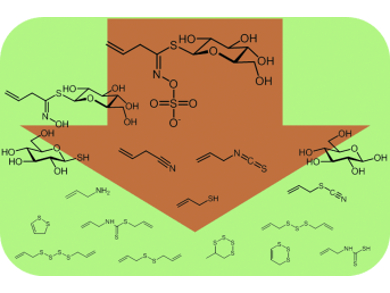Reactivity of Glucosinolates and their Breakdown Products in Foods
The taste and nutritional value of vegetables including broccoli, radishes, and cabbage are influenced by specific substances, namely glucosinolates (mustard oil glycosides) and their numerous breakdown products. The positive and negative effects of these compounds on human health are also the subjects of fierce debate. As it turns out, the actual substances present depend greatly on the preparation of the vegetables, report German scientists in the journal Angewandte Chemie.
Health Effects of Glucosinolates
Glucosinolates consist of a glucose molecule and a sulfur-containing group of atoms by way of which a very wide variety of side chains can be attached. The plant uses these substances and their breakdown products as protection against predatory herbivores and microbial attack. Positive health effects have been reported for humans: many of these substances demonstrate antibiotic and anti-inflammatory effects, as well as helping to prevent cancer and fight tumors.
One important group of breakdown products is the isothiocyanates. Studies indicate that these compounds fight cancer in some stages. Conversely, it has been reported that these substances may trigger DNA mutations, leading to cancer. Excessive consumption of cabbage varieties is reported to promote goiter formation. “Though only in conditions of low dietary iodine,” explains Franziska Hanschen. “The more significant problem seems to be that some of the breakdown products can also react with proteins, affecting the bioavailability of amino acids. This may promote protein deficiency in a vegetarian diet.”
Breakdown Process Depending on Food Preparation
“Information about the bioactivity of glucosinolates is only useful if we know what compounds are formed during food processing and subsequently eaten,” says Hanschen. “Different methods of preparation can lead to very different profiles of breakdown products.”
Working with colleagues at the Leibniz Institute of Vegetable and Ornamental Crops Grossbeeren and Erfurt e.V., the Freiburg University Medical Center, and the University of Hamburg, she has now compiled a comprehensive and detailed review of the chemical reactivity of various glucosinolates and the breakdown products formed during food preparation.
The degradation of glucosinolates begins as soon as the cells of the vegetable are broken open during processes such as chewing or cutting. At this point, the cells come into contact with myrosinase, an enzyme that occurs in the plants themselves. Whereas glucosinolates are mostly preserved during steaming, up to 50% may be leached out during blanching. High heat deactivates the myrosinase, halting enzymatic degradation. Instead, an increased number of chemical breakdown processes occur, which depend on a variety of factors such as pH value, concentration of iron ions, or the water-content of the plant. Milder heating results in the formation of more isothiocyantes than longer heating at higher temperatures.
“The high number of heterogeneous breakdown and reaction products that can participate in bioactivity makes the risk/benefit analysis more difficult,” says Hanschen. “Further systematic studies of the chemical mechanisms involved and the substances present are necessary.”
- Reactivity and Stability of Glucosinolates and their Breakdown Products in Foods,
Franziska S. Hanschen, Evelyn Lamy, Monika Schreiner, Sascha Rohn,
Angew. Chem. Int. Ed. 2014.
DOI: 10.1002/anie.201402639




